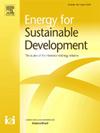Development of LPG in Pakistan: Factor productivity and efficiency perspectives
IF 4.4
2区 工程技术
Q2 ENERGY & FUELS
引用次数: 0
Abstract
Liquefied petroleum gas (LPG) is quickly becoming an imperative part of Pakistan's energy mix, with huge future potential. However, there are still some reservations about the degree of its potential market, which leads to supply shortages. Thus, these scarcities establish the main objective of encouraging LPG to be a key fuel in various sectors. The research investigates the decomposition of key driving factors and their economic efficiency under countries' economic plans from 1987 to 2021. The results show that (i) from 1987 to 2021; LPG increased hugely because of growth in income-level; (ii) population is the second major factor in growing LPG; however, the intensity effect added maximally to LPG; (iii) domestic and commercial sectors contributed to huge consumption, which added 537.05 and 1201.7 billion dollars to the economy during the period, while the industrial sector added 3641.08 billion dollars from 2002 to 2021 followed by population and income effects. Income level is the only factor presenting positive outcomes except for the recent phase (2017–2021) due to COVID-19. (iii) Energy Efficiency Accounting Systems remained positive and significant in all phases, excluding the crisis period (2007–2011) and epidemic phase (2017–2021), while economic-wide efficiency showed optimistic results. Finally, structural change and technological enhancement can sustain the income of consuming sectors.
巴基斯坦液化石油气的发展:要素生产率和效率的观点
液化石油气(LPG)正迅速成为巴基斯坦能源结构的重要组成部分,具有巨大的未来潜力。然而,人们对其潜在市场的程度仍有所保留,这导致了供应短缺。因此,这些稀缺性确定了鼓励液化石油气成为各个部门关键燃料的主要目标。本研究考察了1987 - 2021年各国经济计划下的关键驱动因素分解及其经济效率。结果表明:(1)1987 ~ 2021年;由于收入水平的提高,液化石油气价格大幅上涨;(ii)人口是石油气增长的第二大因素;但强度效应对液化石油气的影响最大;(3)国内和商业部门在这一时期为经济贡献了5370.5亿美元和12017亿美元的巨大消费,工业部门在2002年至2021年期间为经济贡献了36410.8亿美元,其次是人口和收入效应。除了最近阶段(2017-2021年)受新冠疫情影响外,收入水平是唯一呈现积极成果的因素。(三)除危机期(2007-2011年)和疫情期(2017-2021年)外,能效核算系统在所有阶段都保持积极和重要的作用,而整个经济的效率显示出乐观的结果。最后,结构变革和技术提升可以维持消费部门的收入。
本文章由计算机程序翻译,如有差异,请以英文原文为准。
求助全文
约1分钟内获得全文
求助全文
来源期刊

Energy for Sustainable Development
ENERGY & FUELS-ENERGY & FUELS
CiteScore
8.10
自引率
9.10%
发文量
187
审稿时长
6-12 weeks
期刊介绍:
Published on behalf of the International Energy Initiative, Energy for Sustainable Development is the journal for decision makers, managers, consultants, policy makers, planners and researchers in both government and non-government organizations. It publishes original research and reviews about energy in developing countries, sustainable development, energy resources, technologies, policies and interactions.
 求助内容:
求助内容: 应助结果提醒方式:
应助结果提醒方式:


